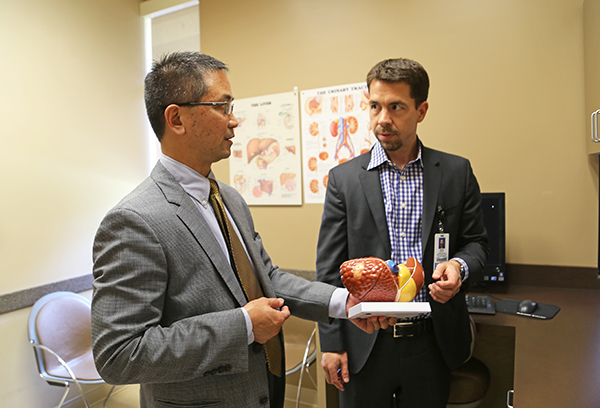Patients receiving a liver transplant at Loma Linda University Health have the best chance of survival for all programs in Southern California and the second-best in all of California, according to recent numbers released by the Scientific Registry of Transplant Recipients — better known as SRTR.
SRTR is the organization tasked by the U.S. Department of Health and Human Services with compiling these and other statistics related to transplantation. The recent numbers placed the Transplantation Institute at 94.44 percent survival after one year (source: SRTR.org).
Michael de Vera, MD, director of the Transplantation Institute, calls these latest statistics very encouraging: “It tells us that our efforts over the last five years are paying off.”
Surgeons at the Transplantation Institute have performed more than 500 liver transplant surgeries to date. The first such transplant at Loma Linda University Health was performed in 1993.
There are some key differences between the Transplantation Institute at Loma Linda and other similar centers around the country, and de Vera believes these have contributed to the organization’s success.
“All physicians and 50-plus staff members of our institute are physically located in one place,” de Vera points out. “This allows us to work in unison toward our goals and provide more coordinated care, in addition to being more convenient for patients.”
The Transplantation Institute also shares the Loma Linda concept of “whole person care,” providing extensive counseling on diet and healthy lifestyle, as well as organizing support groups for patients and their caregivers in an environment that welcomes each person’s spirituality and individuality.
The transplant surgery team, in addition to de Vera, consists of Pedro Baron, MD; Philip Wai, MD; and Arputharaj Kore, MD.
Four hepatologists provide pre-transplant and post-transplant care. This group includes Lydia Aye, MD; Jason Cheng, MD; and Khaled Selim, MD, and is led by Michael Volk, MD, MSc, who is also chief of gastroenterology. They look forward to a fifth member, Mina Rakoski, MD, who will join them in October.
In addition to the surgeons and hepatologists, the Transplantation Institute team includes clinical directors, nurse coordinators, social workers, transplant assistants, financial coordinators, dietitians, pharmacists and others.
“Our staff are critical to our success,” Volk adds. “It takes a team to care for each of our patients and we are committed to their welfare.”
Another important feature of the liver transplant program is the focus on community outreach. “We have a number of clinics that help us serve a wider area,” Volk explains. “Our surgeons and hepatologists travel to these clinics, where we meet our patients and interact with their communities.”
Outreach clinics in Southern California are centered in Rancho Cucamonga, Glendale and Murrieta. A fourth clinic is located in Las Vegas, Nevada. A fifth is under consideration in East Los Angeles.
The Transplantation Institute oversees adult and pediatric heart transplants, adult liver transplants, adult and pediatric kidney transplants, adult pancreatic transplants and pediatric bone marrow transplants. Combination transplants are performed as needed, including kidney/pancreas, liver/kidney, liver/pancreas, and heart/kidney.
Appointments can be scheduled by calling 1-844-LIVER-LL.

